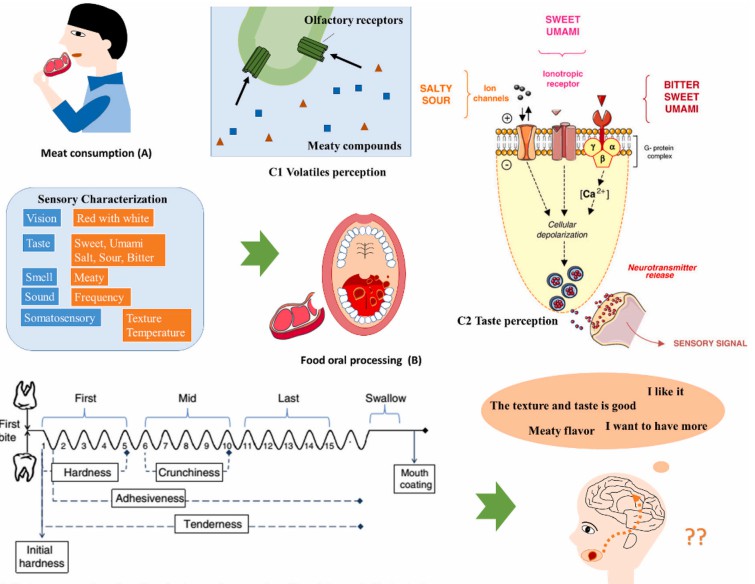There is a growing market for cultured meats. These products are popular among vegans or vegetarians, and, in addition, flexible vegetarians may purchase cultured meats to reduce meat consumption. They must meet various factors such as appearance, flavor (aroma and taste), and texture. The taste and texture of cultured meats are highly rated by many consumers and are critical to consumer acceptance. Therefore, for developing new foods, characterization techniques should be used to help simulate and mimic traditional meat textures. These tools can facilitate the integration of meat alternatives into existing recipes and accelerate customer acceptance by capturing inherent attributes similar to traditional products.
 Fig.1. Meat perception during food oral processing. (Chen Y P, et al., 2022)
Fig.1. Meat perception during food oral processing. (Chen Y P, et al., 2022)
To meet consumers' ethical, social, health and ecological well-being, food producers are increasingly focusing on the acceptability of cultured meat to consumers in terms of taste, texture, flavor, and flavour. As an ideal partner in the cultured meat sector, Lifeasible offers specialized solutions for evaluating the sensory characteristics of cultured meat. Our goal is to help food producers obtain cultured meat with excellent appearance, flavor, and texture.
❖ Measurement of Dynamic Rheological Properties of Cultured Meat
The measurement of dynamic rheological properties is very important in controlling the quality of cultured meat. We use rheometers to analyze the effect of emulsifiers or different liquid additives on cultured meat.
❖ Cooking Loss Analysis of Cultured Meat
Steaming loss indicates the degree of shrinkage of meat during cooking and is an important indicator for evaluating the quality of meat. We offer a cooking loss analysis service for cultured meat to reflect its juiciness and yield.
❖ Moisture Holding Capacity Analysis of Cultured Meat
The water holding capacity affects the quality and yield of fresh meat or its products. We offer water-holding capacity analysis of cultured meat to reflect the ability of proteins in cultured meat to retain water and form protein gel networks. The higher the water-holding capacity in the cultured meat, the more succulent it will be.
❖ Texture Profile Analysis of Cultured Meat
The texture of cultured meat is an important factor in stimulating the sensory taste of the muscle. We offer texture profile analyzers to detect texture differences in cultured meat, including firmness, juiciness, chewiness, etc.
❖ Color Analysis of Cultured Meat
We offer UV/VIS spectrum-based color analyzers to measure the color of cultured meat.
❖ Microstructure of Cultured Meat
We have an advanced electron microscope platform to observe the microstructure of cultured meat.
❖ Sensory Evaluation of Cultured Meat
We have experienced evaluators for sensory evaluation of cultured meat, who are graduate students and staff of the Department of Food Science and Biotechnology. Sensory evaluation is performed at each booth based on hardness, elasticity, stickiness, firmness, roughness, bean flavor, oiliness, juiciness, and overall acceptability.
Flavor, aroma, and texture are important factors in obtaining quality cultured meat. Whether you want to improve the sensory characteristics of cultured meat or evaluate the sensory characteristics of your existing cultured meat, Lifeasible always provides the perfect solution. In a quantitative and fast way, using the proposed methodology, our researchers can adjust different ingredients, additives, or process parameters to simulate the sensory characteristics of cultured meat already accepted by our customers. Feel free to contact us for more information.
Reference